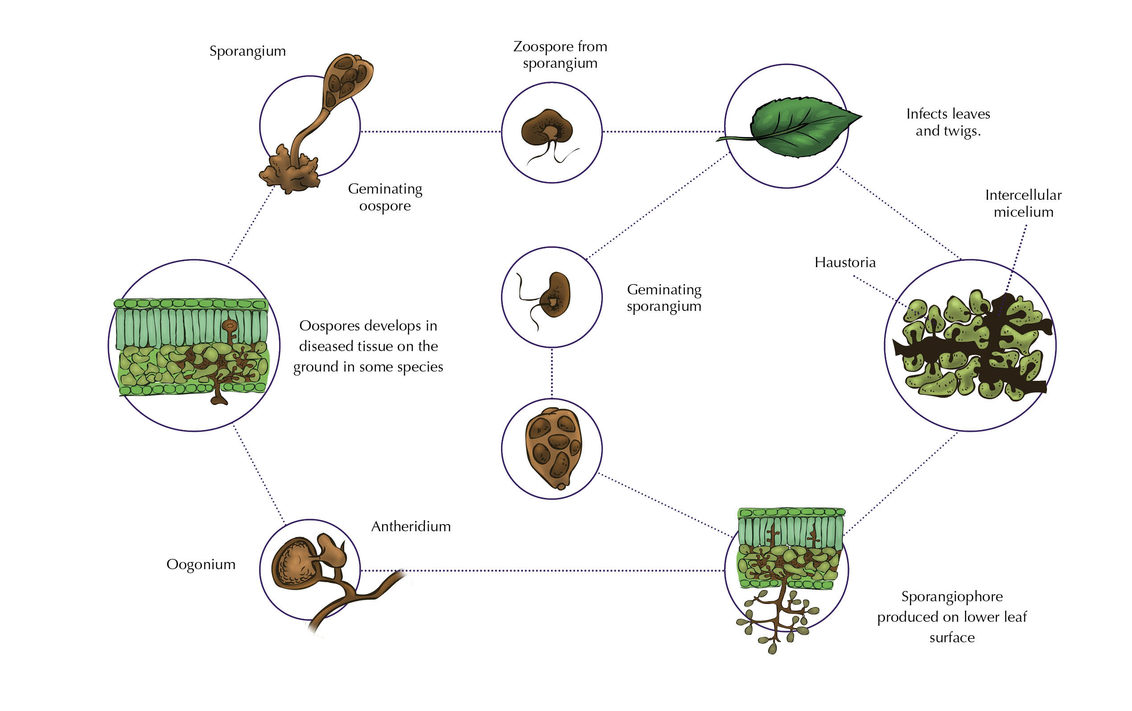Downy Mildew in Roses

Downy mildew diseases pose a serious problem in the Kenyan horticultural industry causing heavy losses in many floricultural and greenhouse crops.
Dr. Samuel Nyalala, Department of Crops, Horticulture and Soils, Egerton University shares in sights on the disease.
Downy mildew is caused by Peronospora sparsa, a fungus-like eukaryotic microorganism (oomycete), more closely related to algae than to fungi. P. sparsa is an obligate parasite that establishes long term feeding relationship with rose plant and its growth depends on the living plant tissues.
The pathogen grows between the host cells and invades the plant tissues by producing nutrient-absorbing structures called haustoria. Spore production and infection occur during extended periods of cool and humid weather: The sporangiophores and sporangia appear on the lower leaf surface. A complete life cycle can occur in 72 hours. The pseudo fungus penetrates the host through the cuticle and epidermis, and feeds on parenchymal cells via haustoria and intercellular mycelium profuse network.
As the infection progresses, sucrose and other nutrients move from the leaves to new infection zones originated by localized injuries. When sporangia are mature, they spread by the wind to developing foliage and flowers. Symptoms usually develop within 11 days after infection, with sporulation occurring 5 - 11 days later.
P. sparsa has been detected in the cortex of stems and root tissues of symptomatic plants and crown tissues of a symptomatic mother plants used as a source of propagation material the disease therefore starts on bare-rooted, apparently healthy stocks and infect new stems and emerging leaves as they develop.

Downy mildew pathogen thrives best under conditions with 90 - 100% humidity and relatively low temperatures (10 - 24°C). Therefore, rose downy mildew occurs mainly in greenhouses, rather than outdoors. High-risk seasons with a downy mildew incidence >10% coincided with months when the number of hours per day with temperature of 15 - 20°C averaged >9.8 over the month and the number of days with rainfall in the month was >38.7%. The disease starts as small angular yellow spots or chlorotic lesions on the upper surface of leaves (Figure 2a). These lesions quickly turn into red, purple or dark brown blotches, which are surrounded by a chlorotic halo.
On the underside of the leaves, the signs of the pathogen include occurrence of a light brown mycelium with abundant production of sporangiophores and sporangia, creating hairy appearance. On the stems and Calyx, the disease manifests as dark purple spots that vary in size and may even coalesce inducing death of branches and mummification of flower buds. Foliar symptoms of the disease are usually mistaken for abiotic stresses such as burns or pesticide phytotoxicity, rendering correct diagnosis difficult. Greenhouse management: Maintaining low humidity levels and avoiding sudden temperature drops during the night is the most effective way to prevent downy mildew epidemic.
Avoid high humidity especially during the rainy seasons
Cultural practices: Irrigation practices that do not wet the plant foliage are essential to decrease incidence and severity of downy mildew. Sanitation practices such as the removal and destruction of infected material such as stems, leaves and symptomatic flowers, are necessary to reduce the level of inoculum in the crop.
Crop nutrition
Nutritional elements such as nitrogen (N), potassium (K), calcium (Ca), boron (B), Silicon (Si) and nutrients ratios such as N: K ratio are important in increasing resistance to obligate parasites like P. sparsa.
Biological control
Use of Bacillus subtilis as a rotation in a management program of P. sparsa.
Use of fungicides
Chemical control of downy mildew in roses should be based on the recommendations of the Fungicide Resistance Action Committee (FRAC). There is need to rotate fungicides from different chemical groups to avoid development of resistance by the pathogen.